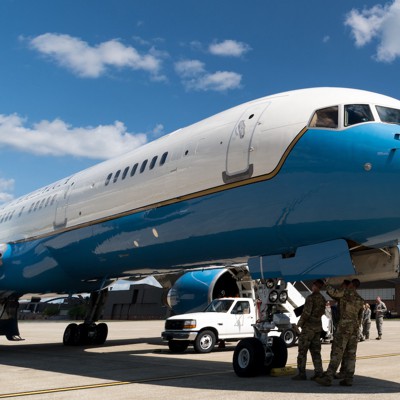The Pentagon is abandoning plans to replace its small fleet of Boeing 757s that serve as Air Force Two—the jetliners that fly the vice president and other top-level cabinet officials.
Funding for the project has been eliminated in the Air Force’s fiscal 2022 budget request, which was sent to Congress on Friday.
“After 2020, remaining funding in [for the effort] was applied to the evaluation and maturation of advanced high speed transport scale aircraft with potential to expand the defense industrial base and serve as C-32A replacements at the appropriate time,” budget documents state.
Last year, the Air Force awarded contracts to develop fast-moving executive transport planes to three startup companies: Exosonic and Boom Supersonic, which are developing supersonic passenger jets; and Hermeus, which is developing a hypersonic passenger aircraft.
The nixing of an Air Force Two replacement comes three months after Gen. Jacqueline Van Ovost, head of Air Mobility Command, called the C-32A—the military designation for the Boeing 757—“a very capable aircraft.”
“We have the executive communications onboard and we've been modifying that to ensure that our senior leaders remain connected at all times,” Van Ovost said during a Feb. 24 briefing with reporters.
The C-32A is also a back-up to the larger VC-25, the Boeing 747 used by the president. The president occasionally uses the C-32 to fly to airports with runways too short for the VC-25.
The 757 is unique in that it can fly long distances from runways too short for larger, wide-body airplanes. Boeing stopped making the 757 in 2005. Earlier this year, the company resumed work on designing a replacement after those efforts were put on hold in 2020 as the company focused on fixing problems with the 737 Max.
Four years ago, the C-32A was part of an Air Force and Navy study that looked at replacing VIP transports and three other types of command-and-control planes with a single aircraft. However, an analysis that wrapped up in September 2020 recommended “no impact or actions for the C-32 fleet,” according to Air Force budget documents.
“Right now, we are not moving forward with any sort of combination of big airplane—single tube—that can do multiple missions for the executive airlift side,” Van Ovost said.
The Air Force is still moving forward with the plans to replace the E-4B National Airborne Operations Center—more commonly known as the “Doomsday plane” because it can send the nuclear weapon launch codes to aircraft, missile silos, and submarines.

 www.defenseone.com
www.defenseone.com
Funding for the project has been eliminated in the Air Force’s fiscal 2022 budget request, which was sent to Congress on Friday.
“After 2020, remaining funding in [for the effort] was applied to the evaluation and maturation of advanced high speed transport scale aircraft with potential to expand the defense industrial base and serve as C-32A replacements at the appropriate time,” budget documents state.
Last year, the Air Force awarded contracts to develop fast-moving executive transport planes to three startup companies: Exosonic and Boom Supersonic, which are developing supersonic passenger jets; and Hermeus, which is developing a hypersonic passenger aircraft.
The nixing of an Air Force Two replacement comes three months after Gen. Jacqueline Van Ovost, head of Air Mobility Command, called the C-32A—the military designation for the Boeing 757—“a very capable aircraft.”
“We have the executive communications onboard and we've been modifying that to ensure that our senior leaders remain connected at all times,” Van Ovost said during a Feb. 24 briefing with reporters.
The C-32A is also a back-up to the larger VC-25, the Boeing 747 used by the president. The president occasionally uses the C-32 to fly to airports with runways too short for the VC-25.
The 757 is unique in that it can fly long distances from runways too short for larger, wide-body airplanes. Boeing stopped making the 757 in 2005. Earlier this year, the company resumed work on designing a replacement after those efforts were put on hold in 2020 as the company focused on fixing problems with the 737 Max.
Four years ago, the C-32A was part of an Air Force and Navy study that looked at replacing VIP transports and three other types of command-and-control planes with a single aircraft. However, an analysis that wrapped up in September 2020 recommended “no impact or actions for the C-32 fleet,” according to Air Force budget documents.
“Right now, we are not moving forward with any sort of combination of big airplane—single tube—that can do multiple missions for the executive airlift side,” Van Ovost said.
The Air Force is still moving forward with the plans to replace the E-4B National Airborne Operations Center—more commonly known as the “Doomsday plane” because it can send the nuclear weapon launch codes to aircraft, missile silos, and submarines.

Pentagon Shelves Plans for New Air Force Two
In the meantime, the Air Force is in the early stages of developing supersonic and hypersonic passenger aircraft.

